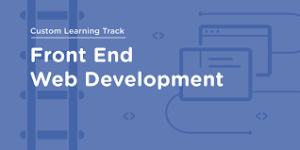Introduction
Given the ever-increasing rates of development of technologies, front-end web development belongs to the key components of internet architecture. Front-end developers are at the same time the builders of the web, as well as the constructors of certain elements of websites and web applications that the users interface with. These professionals are innovative while at the same time creating, converting designs into practical, responsive, and accessibility focused websites.
In this article, we need to know the definitions, jobs, role, skills, and career opportunities of front-end development for those who are beginners or thinking to switch their career in this field. In this definitive step-by-step guide, you will learn the details on how to become a front-end web developer.
Front-End Web Development
Front-end web development is the procedure of building the website or web application user interface (UI) and user experience (UX). It consists in programming the elements that are drawn and the interoperations directly enacted by the user such as the buttons, the menus, some fields, the animations and the overall organization of the Web site.

Front-end development is primarily concerned with three main technologies:
HTML (Hypertext Markup Language): HTML forms the framework of every website and it consists of the basic layout and the texts to be displayed.
CSS (Cascading Style Sheets): CSS works by putting designing and formatting to the HTML elements. It defines how colours, font, margins and other spacing are done giving developers a way to come up with a perfect looking design.
JavaScript: JavaScript makes Web sites dynamic or interactive. These features include enabling of dynamic content, controlling of multimedia, images animation, among others.
Role of a Front-End Developer
In the previous sections, it was discussed that a Front-end developer has different tasks that one has to complete on a daily basis. Here’s what a typical front-end developer does:This is what front-end developers get up to:
Building User Interfaces (UI): Front end developers directly code from graphic designs using tools such as XD, Figma, Sketch or any other alternative. They assist in ensuring that what is designed appears as it was intended to especially on different devices and not differently on one browser.
Enhancing User Experience (UX): Besides the appearance, developers also consider how website is usable and efficient, which implies that the website is accessibility to a person with a disability.
Cross-Browser Compatibility: Web sites should be responsive in the various web browsers ( for example Chrome, Firefox, Safari and Edge). They essentially have to make their code conform to these restrictions of real world browsers and they do this through trial and error.
Responsive Design: With the increasing number of users, who employ smartphones or tablets, the developers are to take into consideration the aspect of website’s responsiveness, which is the process of its transition to another size.
Performance Optimization: Web developers do their best to make their site fast loading and do their best to support the speed in any way possible. This may refer to image rasterisation and file formats such asjpeg, bmp, GIF, as well as compression techniques, cached storage memory and code density.
Collaboration: Jasons are in many cases in one group with back-end developers, UX/UI designers and content creators to implement a project.
Skills for Front-End Web Developers
When it comes to front-end web development, one must have a combination of technical and soft skills for him or her to perform a good job.

Technical Skills
HTML/CSS Mastery:
Semantic HTML: Many suggestions concern the perfectly balanced and semantic HTML that can be provided for the differently abled populace.
CSS Flexbox and Grid: The most recent methods used in the development of successively adaptable grid page layouts.
Preprocessors (SASS/LESS): Pre-processors which add to CSS properties like variables, nesting, and mixins.
JavaScript Proficiency:
ES6+ Syntax: Doing up to date JS features such as Arrow functions, Destructuring and Promises.
DOM Manipulation: Communicating with the Document Object Model (DOM) allow for changes to be made on this UI in real time.
AJAX and Fetch API: The methods to use in making asynchronous HTTP requests to loading data without the need for refreshing the page.
Frameworks and Libraries:
React. js: A light-weighted , open source JavaScript library that is used for enhancing user interface.
Angular: A strong tool-kit of development for creating cape and interesting single-page applications.
Vue. js: An easily implementable progressive framework.
Version Control/Git:
Git for version control, contribution within developers and using repositories.
Responsive Design:
Media Queries: Techniques of CSS to ensure the websites are good looking on all the available sizes.
Mobile-First Design: A design approach that works from a wrong assumption that it will start work on the smallest screen size and go up.
Browser Developer Tools:
Chrome DevTools which enable solution of debugging challenges, performance optimization problems, as well as code examination challenges.
APIs and RESTful Services:
Using external APIs for extending the application functionality, e.g. payments, geolocation, or allowing users share on social media platforms.
Build Tools:
Webpack: A module bundler the task of which is to compile and bundle the JavaScript code.
NPM/Yarn: Software managers for installation and for managing packages and or libraries and or frameworks and or modules etc.
Educational Pathways
There are no set steps one has to take in order to become a front-end web developer, but there are different ways of education that will enable one to acquire these skills. Here are some options:
1. Formal Education
Bachelor’s Degree in Computer Science: An understanding of programming languages, the use of algorithms and different approaches to software development.
Web Development Bootcamps: Short term high intensity with an emphasis on ‘hands on’ skills development through projects or assignments. Despite the fact that bootcamp often doesn’t have official accreditation it often provides career services and access to professionals.
2. Online Courses and Tutorials
There are also online learning platforms such as Coursera, Udemy, and Codecademy that provide all type of courses right from Learning HTML to advance JavaScript Frameworks.
3. Self-Learning
The majority of front-end developers acquire the basic knowledge by themselves with the help of such sources as MDN, YouTube, and open-source projects.
Career Growth and Advancement
It is noteworthy that front-end web development has rather a wide range of opportunities in terms of the further employment and career growth. As you gain experience, you can specialize in areas like:That way when you are through you can go for sub-sectors such as:
UI/UX Design: To be more specific, it focuses more on the design and the attitude adopted towards the website construction.
JavaScript Framework Specialization: Es significantly important to gain expertise in one of the frameworks like React, Angular or Vue. js.
Full-Stack Development: It means there are more works for you as you do not restrict yourself on, for example, pure front-end development, but in most cases you can work on back-end of any web site.
Technical Leadership: To other progressive positions including Lead Developer , Technical Architect or even CTO once one is able to secure leadership traits. web front-end development is actually a fairly large number of employed possibilities to advance in the direction. As you gain experience, you can specialize in areas.
Building a Portfolio
I want to show you how you can build an impressive front end web development portfolio.Here’s how to build an impressive front-end web development portfolio:
Start Small: So as a lot of things can be vast in the world of web development we could say it is a good idea to start simple with something like a blog, a simple landing page or even a small app and prove you know the basics there.
Contribute to Open Source: Building the profile on the open-source platforms such as GitHub can be beneficial; it will improve experience, contribute to the development and also establish the connection with like-minded folks.
Showcase a Variety of Projects: Add various samples based on your specialization, on the website design for example, you can include both responsive designs, e-commerce websites or single page applications.
Write Case Studies: That is why, for each of the projects, you have to create brief case study in which you have to describe the difficulties, your strategies, the technologies applied, and the results obtained. This give background to your work and show how you solve problems.
Keep It Updated: This they should be updated from time to time as one begins to advance in his or her career with new projects, skills, and experiences acquired in the process.
Conclusion
Front-end web development is one of the hottest trends of today that offers great opportunities to work creatively while being knowledgeable in the given sphere. website front-end developers are crucial intermediaries that work on the difficult task of making web products as engaging, accessible and as responsive as possible. Starting with HTML, CSS, and JS, accompanied by keeping up with new instruments and learning new things, a developer can achieve great success in this continuously developing field. Whether your goal is to become an expert in a certain framework, switch to a manager position, or just make delightful user experiences, there’s a lot you can do in front-end development. Always remain excited, continue learning, and you will be laying all the groundwork for a great profession in front-end web development.








2 thoughts on “Guide to Becoming a Front-End Web Developer”